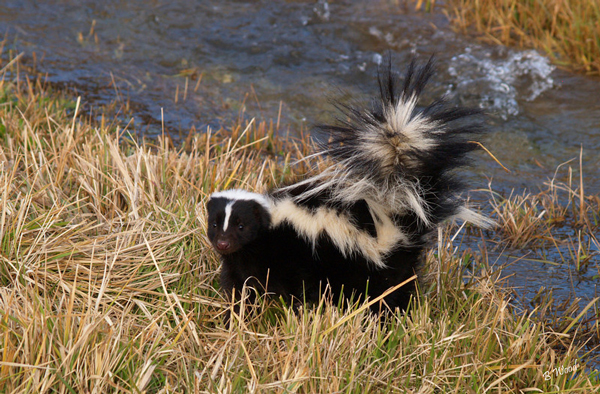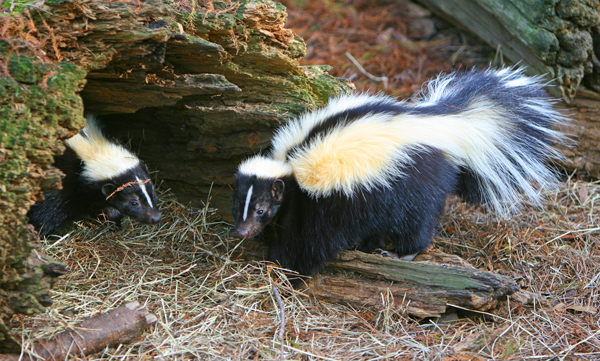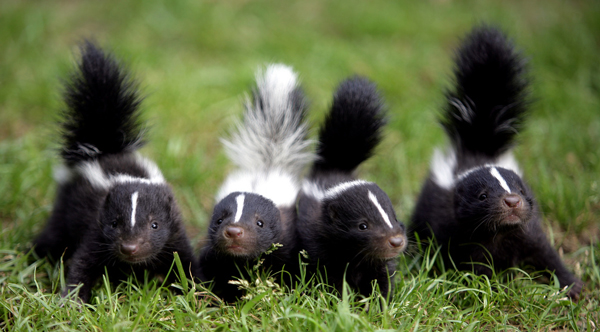



tvor
Tvor ili smrdljivac (Mustela putorius) je divlja životinja, grabljivi sisar iz porodice kuna, poznat po tome da kad je ugrožen ili veoma uzbuđen, štrcanjem izbacuje smrdljivi sekret iz žlezde ispod repa. Ako se oseti ugroženim, upozorava na opasnost lupkanjem nogu ili hodanjem na prednjim nogama, a ukoliko je opasnost i dalje prisutna, izbacuje smrdljivi sekret iz žlezde pored analnog otvora. Oglašava se frktanjem i režanjem. Majstor je bežanja ako mu odbrana ne uspe.
Dugačak je od 40 do 95 santimetara, a teški i do 8 kilograma, s tim što su mužjaci i do tri puta veći od ženki. Imaju vitko, izduženo telo, sa relativno kratkim i veoma mišićavim nogama, i duge kandže na prednjim šapama za kopanje. Ima crno ili kestenjasto krzno, koje je na trbuhu žuto ili belo, a na licu ima bele šare. Oni mogu imati jednu debelu traku preko leđa i repa, ili dve tanje trake, ili niz belih mrlja i isprekidanih prugica. Neki imaju i pruge na nogama. Najrazvijenije mu je čulo njuha.
Hrani se miševima, pacovima, vodozemcima, pticama i ptičjim jajima, zečevima, gušterima, ribama i puževima. Ponekad jede i voće. Opasan je i za domaću živinu. U potrazi za hranom spreman je da napadne i dva puta veću životinju od sebe. Interesantan je način na koji sprema žabe kao zalihu hrane. Ugrizom ošteti žabi nerve, pa ona ostaje živa, ali ne može da se kreće.
hamarosan
European polecat
The European polecat (Mustela putorius) — also known as the black or forest polecat, or fitch (as well as some other names) — is a species of mustelid native to western Eurasia and North Africa. It is of a generally dark brown colour, with a pale underbelly and a dark mask across the face. Occasionally, colour mutations, including albinos and erythrists, occur.
Compared to minks and other weasels — also fellow members of the genus Mustela — the polecat has a shorter, more compact body; a more powerfully built skull and dentition; is less agile; and it is well known for having the characteristic ability to secrete a particularly foul-smelling liquid to mark its territory. It is much less territorial than other mustelids, with animals of the same sex frequently sharing home ranges.
Like other mustelids, the European polecat is polygamous, though pregnancy occurs directly after mating, with no induced ovulation. It usually gives birth in early summer to litters consisting of five to 10 kits, which become independent at the age of two to three months. The European polecat feeds on small rodents, birds, amphibians and reptiles. It occasionally cripples its prey by piercing its brain with its teeth and stores it, still living, in its burrow for future consumption.
Europäischer Iltis
Der Iltis ist ein kleines Raubtier und gehört zur Familie der Marder. Er lebt in Nordamerika, Asien und in Europa. Der europäische Iltis wird etwa 45 cm groß und höchstens 1,5 kg schwer. Sein Fell ist dunkelbraun gefärbt mit einem gelblichen Unterhaar. Auffällig an seinem Kopf ist, dass er rund um die Augen und den Ohren sowie an der Schnauzenspitze weiß gefärbt ist. Der Iltis hat einen langen, buschigen Schwanz.
Der Iltis lebt meistens auf dem Boden. Er klettert nur selten auf Bäume. Seine Nahrung besteht aus Ratten, Mäusen, Fröschen und Maulwürfen. Der Iltis jagt vor allem in der Nacht. Das Iltisweibchen bekommt ein- bis zweimal im Jahr nach einer Tragzeit von etwa 40 Tagen vier bis sieben (ausnahmsweise bis zwölf) Junge. Die Jungen sind bereits nach drei Monaten selbstständig. Iltisse können über zehn Jahre alt werden. Sie sind vom Aussterben bedroht.


